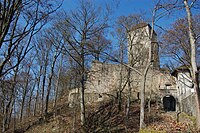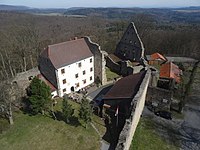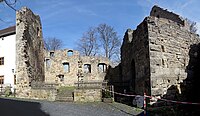Lichtenburg ruins
| Lichtenburg ruins | ||
|---|---|---|
|
Lichtenburg ruins - etching by C. Wagner from 1835 |
||
| Creation time : | 1159 | |
| Castle type : | Höhenburg, hillside location | |
| Conservation status: | essential parts received | |
| Place: | Ostheim in front of the Rhön | |
| Geographical location | 50 ° 28 '38 " N , 10 ° 13' 47" E | |
| Height: | 482 m above sea level NHN | |
|
|
||
The Lichtenburg is the ruin of a hilltop castle at 481.6 m above sea level. NHN high Schloßberg north of Ostheim before the Rhön in Bavaria.
history
The castle was first mentioned in a document in 1159; at that time it was owned by a branch line of the Counts of Henneberg . The founder of the castle is likely to have been Heinrich I von Henneberg-Irmelshausen, the most important lord of the castle, the minne poet Otto I von Henneberg-Botenlauben . The Marschalk von Ostheim sat at the castle as ministerials of the Henneberger .
In 1230 the Lichtenburg was referred to as a castrum in a sales document . The Fulda abbot Heinrich VI. had the castle fortified better in 1315 and build the keep . From this time on, the Lichtenberg office was administered and protected from the Lichtenburg. Around the middle of the 14th century, the castle came back into the possession of the Hennebergers, this time the Henneberg-Römhild family branch, later in Saxon possession. The Peasants' War caused major damage in the 16th century, but reconstruction took place quickly. The last bailiff, Friedrich Sebastian von Stein, left the castle in 1680. The administration of the Lichtenberg district took place from now on from Ostheim and the Lichtenburg lost its importance as an official residence.
At the same time, 1671/1672, however, it was again briefly equipped for military purposes. During the Imperial War against France , it received an iron-studded gate and new ramparts. In 1719 it was finally abandoned and should be demolished.
Carl August von Weimar acquired the facility, and Ernst August von Sachsen-Weimar-Eisenach had restoration work carried out on the decaying structure in the middle of the 18th century, which was discontinued in 1744. From 1811 the facility even served as a quarry for the Ostheimers and was once again exposed to destruction. In two steps, 1819 and 1843, the government of the time bought up the remains. An association for the preservation of the castle and the beautification of its surroundings took on the Lichtenburg.
Todays use
In addition to a restaurant, the ruin observation tower attracts visitors. The knight's hall of the castle can be rented for events.
description
The Lichtenburg is enclosed by an extensive rampart. A paved access road leads to the gate and gatehouse. This part of the complex dates from the Renaissance period ; originally there was probably a drawbridge here. The keep , which has original masonry up to a height of 28 meters, was expanded into a lookout tower with a platform and roof. With a total height of over 31 meters, it is the highest keep in the Rhön. With its outer bailey , specially fortified main castle , palas , bower , stable and chapel , the Lichtenburg still shows features of a knight's castle.
photos
Trivia
The keep of the Lichtenburg is the setting for the novel Der Turm by Uwe Müller .
Web links
- Information and pictures
- Rhön Lexicon
- Restaurant to Lichtenburg
- Castle restaurant of the Rhönklub branch club Ostheim
- Reconstruction drawing in the medieval state








